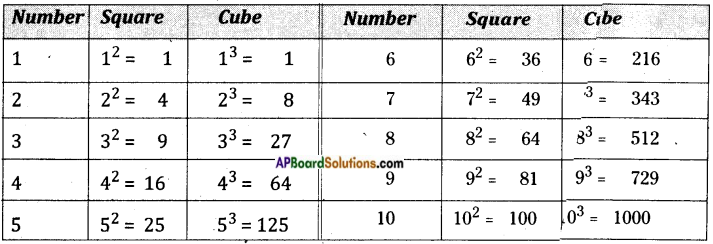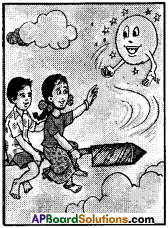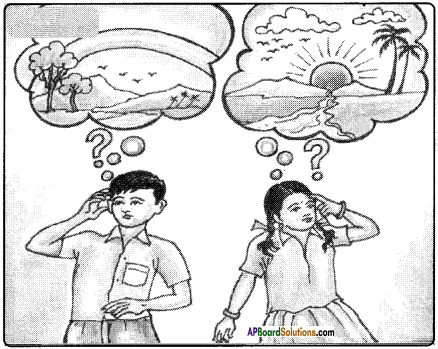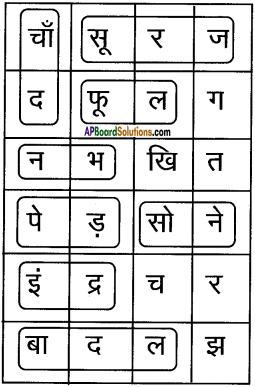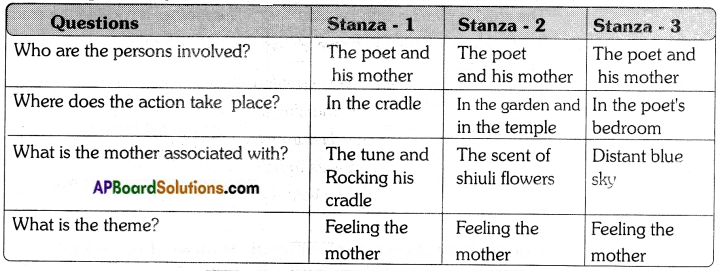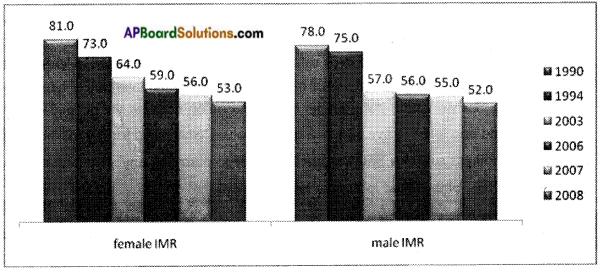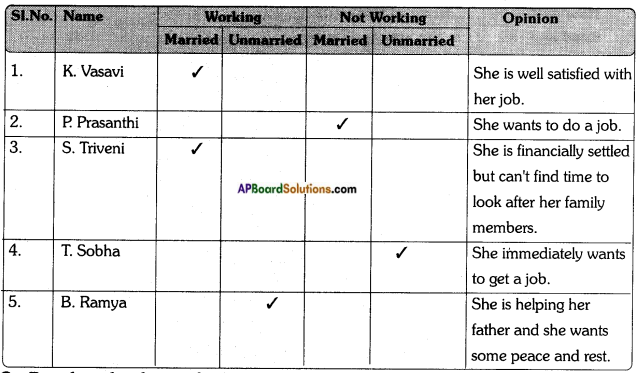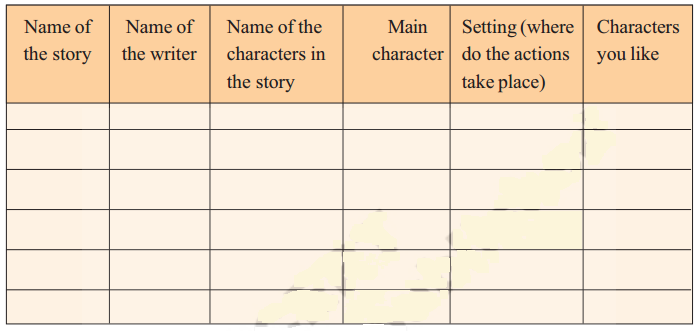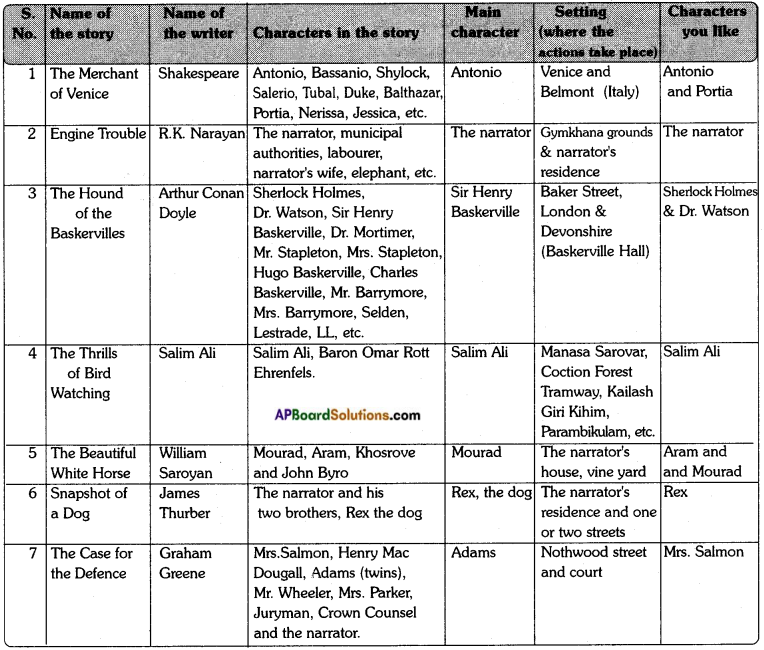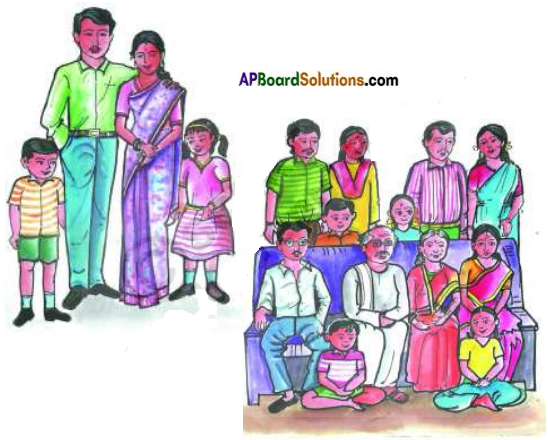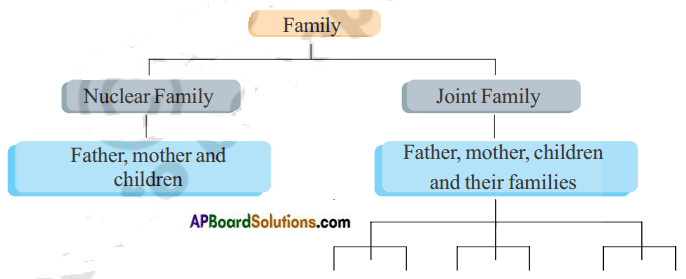AP State Syllabus AP Board 8th Class Hindi Textbook Solutions Chapter 6 दिल्ली से पत्र Textbook Questions and Answers.
AP State Syllabus 8th Class Hindi Solutions Chapter 6 दिल्ली से पत्र
8th Class Hindi Chapter 6 दिल्ली से पत्र Textbook Questions and Answers

प्रश्न 1.
चित्र में क्या – क्या दिखाई दे रहा हैं?
उत्तर:
चित्र में मॉनिटर, की बोर्ड और एक खत लिए कबूतर दिखाई दे रहे हैं।
प्रश्न 2.
कबूतर क्या कर रहा है?
उत्तर:
कबूतर अपने मुँह में चिट्ठी रखकर पावों से कंप्यूटर को दबा रहा है।

प्रश्न 3.
इस लिन से हालें क्या मालूम होता है?
उत्तर:
इना, इस चित्र से हमें मालूम होता है कि समय में कितना परिवर्तन आया है। पुराने ज़माने में कबूतरों के द्वारा चिट्ठी भेजे जाते थे। लेकिन अब कंप्यूटर के द्वारा कुछ ही पलों में संदेश भेजे जाते हैं। विज्ञान की प्रगति हम इस चित्र में देख सकते हैं। कठिन शब्दायी।
सुनो – बोलो
प्रश्न 1.
पाठ के चित्र देखो। किसी एक के बारे में बताओ।
उत्तर:
पाठ के चित्रों में मैं कुतुबमीनार के बारे में बताता हूँ। कुतुबमीनार सबसे अच्छी इमारत है। यह बहुत पुरानी इमारत है। यह बहुत ऊँची मीनार है। इसकी ऊँचाई 280 फुट के करीब है। इसके ऊपर पहुँचने के लिए 379 सीढ़ियाँ हैं।
प्रश्न 2.
यह पत्र किसके बारे में हैं?
उत्तर:
यह पत्र यात्रा वर्णन के बारे में है।

प्रश्न 3.
सनी को लाल किला देखने पर कैसा लगा होगा?
उत्तर:
सनी तो लाल किले को केवल 26 जनवरी और 15 अगस्त के दिन टी.वी. पर देखता था। लेकिन अब वह उसे प्रत्यक्ष देखने पर अश्चर्यचकित हुआ होगा।
प्रश्न 4.
लाल किले के बारे में अपने विचार बताओ।
उत्तर:
लाल किला देखने में बहुत अच्छा लगता है। इसका नाम जैसा लाल किला है, उसका रंग भी लाल है। लाल किला लाल पत्थर का बना हुआ है। यह एक मज़बूत और सुंदर किला है। मुगल बादशाह शाहजहाँ ने इसे बनवाया था।
प्रश्न 5.
किसी यात्रा से पहले हम क्या – क्या तैयारी करते हैं?
उत्तर:
किसी यात्रा से पहले हमें उस स्थान से संबंधित जानकारी प्राप्त करना चाहिए। टिकट पहले ही आरक्षित करना ताहिए। आवश्यक चीजें जैसे कपडे, साबुन, नारियल का तेल, दाँत मंजन आदि को अपने साथ ले जाना चाहिए। वहाँ के जान – पहचान वालों के फ़ोन नंबर लेना चाहिए।
पढ़ो
अ) पाठ का दूसरा अनुच्छेद पढ़ो । दिल्ली के किस स्थान के बारे में बताया गया है? उसके बारे में दो वाक्य लिखो।
उत्तर:
पाठ के दूसरे अनुच्छेद में दिल्ली के आधुनिक भवन जैसे राष्ट्रपति भवन, संसद भवन के साथ – साथ इंडिया गेट, अक्षरधाम मंदिर, लोटस टेंपुल, संग्रहालय, चिड़ियाघर तथा बापू की समाधि राजघाट के बारे में बताया गया है। यमुना नदी के गोद में बसा यह नगर भारत की राजधानी के साथ – साथ दुनिया के प्रसिद्ध नगरों में से एक है।

आ) पाठ के आधार पर नीचे दिये गये वाक्य के अगले वाक्य लिखो।
जैसे – यह बहुत पुरानी इमारत है। इसे देखकर मैं दंग रह गया।
1. यह एक मज़बूत और सुंदर किला है।
उत्तर:
मुगल बादशाह शाहजहाँ ने इसे बनवाया था।
2. इसमें धूपघड़ी है।
उत्तर:
सूर्य की किरणों के आधार पर यह यंत्र आपको सही – सही समय बता देता है।
3. यदि संसार पर कहीं स्वर्ग है,
उत्तर:
तो वह यहीं है, यहीं है, यहीं है।
4. इसकी ऊँचाई 280 फुट के करीब है।
उत्तर:
इसके ऊपर पहुँचने के लिए 379 सीढ़ियाँ है।
5. मेरे आश्चर्य का ठिकाना न था ।
उत्तर:
मैं ने तो केवल इसे 26 जनवरी और 15 अगस्त के दिन ही टी. वी. पर देखा था।

इ) नीचे दिया गया चित्र देखो । उसके बारे में कुछ वाक्य लिखो।
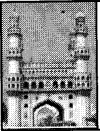
इस इमारत का नाम चारमीनार है। इसको मुहम्मद कुलीकुतुबशाह ने बनवाया। यह हैदराबाद के पुरानी बस्ती में स्थित है। इस इमारत के चारों ओर आकाश को चूमनेवाले चारमीनार होते हैं। ये हिंदु, मुस्लिम, सिख, ईसाई चार धर्मों के प्रतीक माने जाते हैं।
ई) नीचे दिये गये प्रश्नों के उत्तर लिखो।
1. यह पत्र किसने किसे लिखा?
उत्तर:
यह पत्र सनी ने अपने पिताजी को लिखा ।
2. यह पत्र किस दिन और कहाँ से लिखा गया?
उत्तर:
यह पत्र 20 सितंबर, 2012 को नई दिल्ली के सेक्टर 9 ए.से लिखा गया।
3. इस पत्र में किन – किन स्थानों का उल्लेख हुआ है? उनके नाम लिखो।
उत्तर:
इस पत्र में कुतुबमीनार, लाल किला, जामा मसजिद, जंतर-मंतर, हज़रत निज़ामुद्दीन दरगाह, राष्ट्रपति भवन, संसद भवन, इंडिया गेट, अक्षरधाम मंदिर, लोटस टेंपल, संग्रहालय, चिडिया घर तथा बापू की समाधि राजघाट आदि स्थानों का उल्लेख हुआ है।
लिखो
अ) नीचे दिये गये प्रश्नों के उत्तर लिखो।
प्रश्न 1.
सनी ने पत्र क्यों लिखा होगा?
उत्तर:
सनी ने अपने पिताजी को अपनी कुशलता की जानकारी देने के साथ – साथ दर्शाये गये प्रदेशों की जानकारी देने के लिए पत्र लिखा होगा।
प्रश्न 2.
दिल्ली में देखने लायक स्थान क्या – क्या है?
उत्तर:
दिल्ली में देखने लायक स्थान कुतुबमीनार, लाल किला, जंतर – मंतर, राष्ट्रपति भवन, संसद भवन, इंडिया – गेट, लोटस टेंपल, अक्षरधाम, राजघाट, चिड़िया घर और शक्ति स्थल आदि देखने लायक स्थान हैं।
प्रश्न 3.
सनी के इस पत्र का उत्तर देते हुए एक पत्र लिखो।
उत्तर:
विजयवाडा,
दिनांक : x x x x प्रिय पुत्र सनी, आशीर्वाद, दिल्ली से लिखा हुआ तुम्हारा पत्र देखकर मेरे साथ तुम्हारी माँ और बहन जेनी बहुत खुश हुये | तुम्हारी यात्रा बहुत अच्छी रही होगी । हमें इसलिए बहुत खुशी है कि दिल्ली के प्रेदेशों को हम देख नहीं पाये बल्कि तुमने देख लिया । बहन जेनी भी अगले हफ़ते अपनी पाठशाला की तरफ़ से विज्ञान यात्रा के लिए हैदराबाद जा रही है। तुम अपने स्वास्थ्य के प्रति जागरूक रहो। क्योंकि यात्रा में तरह – तरह के प्रदेशों के पानी पीने से स्वास्थ्य बिगड जाएगा। इसलिए थोडा सावधान रहो | अगले महीने के छुट्टियों में घर ज़रूर आना । हम तुम्हें देखना चाहते हैं। माँ और बहन तुम्हें याद किया है। हमारी इच्छा है कि तुम इस बार प्रथम श्रेणी में उत्तीर्ण हो । इस खत का जवाब तुरंत लिखना। हितैषी पिता,
रामाराव. |

आ) इस पाठ का सारांश अपने शब्दों में लिखो ।
उत्तर:
इस पाठ में सनी अपने पिताजी को अपनी विज्ञान यात्रा का वर्णन करते हुए पत्र लिखा था। तीन दिन पहले सनी अपने साथियों और अध्यापकों के साथ दिल्ली पहुँचकर दिल्ली की सैर करने निकले।
सबसे पहले वे कुतुबमीनार देखें । यह एक बहुत पुरानी इमारत और बहुत ऊँचा मीनार है। गुलाम ‘वंश के प्रथम सुल्तान कुतुबुद्दीन ऐबक ने बनवाया था। इसकी ऊँचाई 280 फुट और ऊपर पहुँचने के लिए 379 सीढ़ियाँ हैं। इसके बाद लाल किला देखें। लाल किला लाल पत्थर का बना हुआ है। मुगल बादशाह शाहजहाँ ने इसे बनवाया था । यहाँ “दीवान – ए – खास” स्थान है। इसकी दीवार पर फ़ारसी की पंक्तियाँ लिखी हैं जिसका अर्थ है संसार में पृथ्वी का स्वर्ग यहीं है। किले के पास जामा मसजिद है। इसे भी शाहजहाँ ने बनवाया । इसके बाद जयपुर के राजा “मिर्जा राजा जयसिंह” से बनवाया गया जंतर-मंतर देखें। इसमें एक धूप घडी है। यह सूर्य की किरणों के आधार पर सही समय बता देता है।
दिल्ली के आधुनिक भवनों में राष्ट्रपति भवन तथा संसद भवन के साथ-साथ इंडिया गेट, अक्षर धाम लोटस टेंपल, संग्रहालय और चिडिया घर भी देख लिये। वे बापू की समाधि राजघाट भी देख लिए। अध्यापक जी बताये कि यमुना नदी के गोद में बसा यह शहर भारत की राजधानी ही नहीं प्रसिद्ध नगरों में एक है। अंत में सनी ने तीन दिन में घर लौटने की बात भी बताया ।
शब्द भंडार
अ) नीचे दिये गये चित्र देखो। उनके नाम लिखो। किन्हीं तीन के बारे में दो-दो वाक्य लिखो।
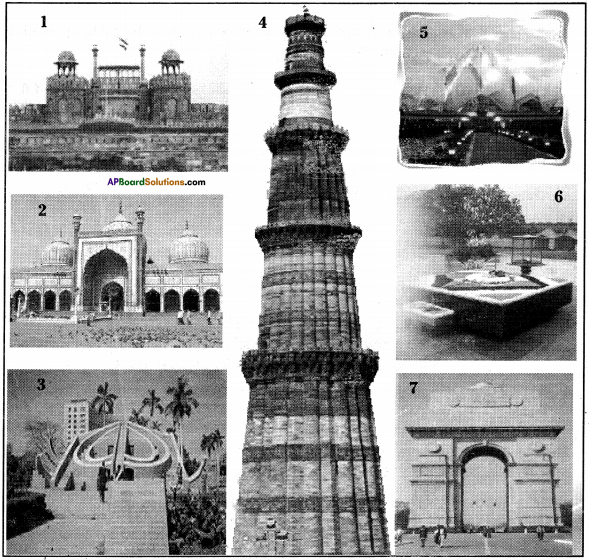
उत्तर:
1. लाल किला :
लाल किला लाल पत्थर से बना हुआ है। यह एक मजबूत और सुंदर किला है। मुगल बादशाह शाहजहाँ ने इसे बनवाया। हमारे राष्ट्रपति और प्रधान मंत्री यहाँ पर 26 जनवरी और अगस्त 15 को झंडा फहराते हैं।
2. जामा मसजिद :
जामा मसजिद को भी कलाप्रेमी मुगल बादशाह शाहजहाँ ने बनवाया। यह एक पुराना मसजिद है यहाँ हज़ारों की संख्या में मुसलमान भाई नमाज़ पढ़ते हैं।
3. जंतर-मंतर :
दिल्ली के पुराने भवनों में जंतर-मंतर भी देखने लायक है। इसे जयपुर के नरेश मिर्जा राजा जयसिंह 1724 में बनवाया था ।
4. कुतुब मीनार :
कुतुब मीनार को गुलाम वंश के प्रथम सुल्तान कुतुबुद्दीन ऐबक ने बनवाया । यह बहुत पुरानी इमारत है। इसकी ऊँचाई करीब 280 फुट और ऊपर पहुँचने के लिए 379 सीढ़ियाँ हैं।
5. लोटस टेंपल :
यह दिल्ली में कल्काजी के पास है। यह देखने में कमल की तरह दीख पडता है। यह संगमरमर से बनाया गया मंदिर है। यह शांति, स्वच्छ और प्रेम का चिह्न है।
इसे रात में देखने से बहुत सुंदर लगता है । यह आधा खिला हुआ कमल के समान दीख पडता है। इसे 1986 में पूरा किया गया।
6. राजघाट :
यह दिल्ली के देखने लायक स्थानों में एक है। यहाँ हमारे जातिपिता बापू की समाधि है । उनके संस्मरणार्थ यहाँ एक ज्योति हमेशा प्रज्वलित रहती है। हर शुक्रवार को यहाँ बापूजी की स्मृति में प्रार्थना गीत गाये जाते हैं।
7. इंडिया गेट :
पहले विश्व युद्ध में जो भारतीय जवान थे उनके यादगार में इंडिया गेट का निर्माण किया गया। यह “राजपथ” नई दिल्ली में स्थित है।
सृजनात्मक अभिव्यक्ति
इस पत्र के कुछ अंश डायरी में लिखो।
उत्तर:
मैंने अपने पिता को मेरी यात्रा के बारे में बताते हुए पत्र लिखा। अध्यापकों की देख – रेख में हमने सब कुछ देखा। वहाँ का मौसम बहुत अच्छा है। मैं ने दिल्ली में कुतुब मीनार, लालकिला, जामा मसजिद, जंतर – मंतर, हजरत निजामुद्दीन का दरगाह, राष्ट्रपति भवन, संसद भवन, इंडिया गेट, लोटस टेंपल, संग्रहालय, चिडियाघर, राजघाट आदि देखें। यमुना की गोद में बसा यह भारत की राजधानी सबका मन मोह लोनेवाला शहर है। वहाँ के विशेष व्यंजन छोले – भटूरे भी खाया है।
प्रशंसा
सैर से मनोरंजन के साथ – साया और क्या लाभ हैं? बताओ।
उत्तर:
सैर से मनोरंजन के साथ – साथ ज्ञान भी प्राप्त होता है। परस्पर सहयोग की भावना बढ़ती है। विविध प्रांतों की सैर से वहाँ के लोगों की संस्कृति, वेश – भूषा, भाषा, आचार-व्यवहार की जानकारी मिलती है। पुराने ज़माने की इमारतों की जानकारी हमें मिलती है। इतिहास की जानकारी के लिए हमें ऐतिहासिक सैर पर जाना चाहिए। इससे हमें इतिहास का ज्ञान भी प्राप्त होता है। इस तरह हम देश के सभी प्रांतों से जुडे रहते हैं।
भाषा की बात
अ) नीचे दिये गये वाक्य पढ़ो।
दिल्ली में मौसम अच्छा है।
कुतुब मीनार पुरानी इमारत है।
लाल किला लाल पत्थर का बना हुआ है।
यह एक मज़बूत और सुंदर किला है।
ऊपर दिये गये वाक्यों में अच्छा,पुरानी, लाल, एक, मज़बूत और सुंदर जैसे शब्द संज्ञा और सर्वनाम की विशेषता बताते हैं। संज्ञा या सर्वनाम की विशेषता बतलाने वाले शब्द विशेषण कहलाते हैं। विशेषण के चार भेद हैं। वे हैं
1. गुणवाचक विशेषण :
जो विशेषण किसी संज्ञा या सर्वनाम के गुण, दोष, दशा, रंग, आकार, स्थिति आदि का बोध कराते हैं, गुणवाचक विशेषण कहलाते हैं। जैसे : रामू अच्छा लड़का है।
2. संख्यावाचक विशेषण :
जो विशेषण वस्तु की संख्या बतायें, वे संख्यावाचक विशेषण कहलाते हैं। जैसे : मैदान में तीन लड़के हैं।
3. परिमाणवाचक विशेषण :
जो विशेषण संज्ञा या सर्वनाम के परिमाण का बोध कराते हैं, उन्हें परिमाणवाचक विशेषण कहते हैं। जैसे : राजू का घर बहुत दूर है।
4. सार्वनामिक विशेषण :
जो विशेषण सर्वनाम के रूप में रहकर संज्ञा को सूचित करते हैं, वे सार्वनामिक विशेषण कहलाते हैं। जैसे : हैदराबाद हमारा शहर है।

आ) पाठ में आये हुए तीन विशेषण शब्द ढूँढो । वाक्य में प्रयोग करो।
जैसे : बड़ी – गंगा भारत की बड़ी नदी है।
1. ऊँचा : अमरनाथ समुद्रतल से 13,500 फुट ऊँचाई पर है।
2. प्रसिद्ध : कलकत्ता देश के प्रसिद्ध नगरों में एक है।
3. मज़ा : पकौडी खाने से मज़ा आता है।
परियोजना कार्य
अपने मनपसंद स्थान के चित्र इकट्ठा करो। उनके बारे में दो – दो वाक्य लिखो । दीवार पत्रिका पर चिपकाओ।
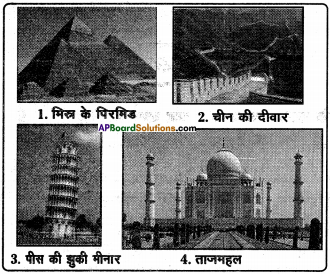
1. मिस्र के पिरमिड :
संसार के सात आश्चर्या में सबसे पहला नाम मिस्र के परिमिडों का आता है। पिरमि मानो मानव द्वारा बनाई गई पहाडी हैं। इन्हें आज से लगभग 5000 वर्ष पहले बनाया गया था। मिस्र राजाओं ने ईंट और पत्थरों से बने इन पहाड जैसे आकारों का निर्माण शाही मुरदों के रखे जाने लिए कराया था। ये संसार की सबसे प्राचीन समाधियाँ अथवा मकबरें हैं।
2. चीन की दीवार :
दीवार से घर को घेरा जाता है। नगर के चारों ओर भी दीवार खींची जाती है। हज़ा किलोमीटर लंबे चौडे देश को भी दीवार बनाकर घेरा गया तो आश्चर्य जनक लगता है। चीन जै विशाल देश के एक कोने से लेकर दूसरे कोने तक 2400 किलो मीटर लंबी एक दीवार बनायी गई र्थ यह विशाल दीवार संसार का एक आश्चर्य मानी गई हैं।
3. पीसा की झुकी मीनार :
यदि दीवार ज़रा भी टेढ़ी हो जाती तो वह खडी नहीं रह पाती फ़ौरन गिर जात . है। पर इस धरती पर एक ऐसी मीनार भी है जो सीधी खडी न होकर टेढ़ी खडी है। वही पीसा की झुट मीनार | इतनी झुकी होने पर भी पीसा की यह प्रसिद्ध मीनार लगभग 800 वर्षों से लगातार खडी है।
4. ताजमहल ः
ताजमहल संसार के सबसे सुंदर भवनों में से एक है। देखनेवालों ने तरह – तरह से ता. की सुंदरता को अपने शब्दों में बांधा है। किसी ने कहा कि ताज संगमरमर में ढ़ली एक कविता है। किर ने कहा “स्वर्ग से गिरा एक आँसू” है। इस महान आश्चर्य को मुगल सम्राट शाहजहाँ ने अपनी बेग अर्जुमंद बानो की याद में बनवाया था । 20,000 से अधिक मज़दूर इस समाधि को बनाने में जुट गएँ मुख्य भवन बारह वर्षों में (1643 ई.में) तैयार हुआ।
दिल्ली से पत्र Summary in English
A boy named Sani wrote a letter to her father describing her educational tour. Three days earlier he visited Delhi and its surrounding places along with her friends and teachers.
First of all, they visited Qutub Minar. This is an Islamic monument as well as the tallest minaret. Sultan – | Kuthubuddin Ibak belonging to the Slave dynasty built this. The tower is 280 feet high and it has 379 stairs to climb it. Later they visited the Red Fort. It was built of red stone. Moghal emperor Shah Jahan built this. A place named ‘Diwan-e-Khas’ is located here. The sentence “This is a paradise in the world” was inscribed on the wall in Parsi language. Jama Masjid is located at the foot. It was also built by Shah Jahan. Later they visited Jantar Mantar built by the Jaipur king ‘Mirza Raja Jaya Simh’. Here the sundial shows the time basing on the sun’s rays.
They visited Rashtrapati Bhavan, Parliament Bhavan, India Gate, Akshar Dham, Lotus Temple, museum and zoo etc., in Delhi. They also visited Rajghat in which Bapuji’s grave is located. The teachers said that this city situated on the banks of the river Yamuna is not only capital of India, but also one of the prominent cities.
Finally Sani wrote in the letter that he would go home in three days.
अर्थग्राहयता - प्रतिक्रिया
निम्नलिखित पद्यांश पढ़कर दिये गये प्रश्नों के उत्तर एक वाक्य में लिखिए |
1. पूज्य पिताजी, सादर प्रणाम।
हम परसों सकुशल दिल्ली पहुँच गये। हमारी यात्रा बहुत अच्छी रही। अध्यापकों ने हमारा बहुत | ध्यान रखा। यहाँ मौसम अच्छा है। कल सुबह नाश्ता करके हम सब लोग दिल्ली की सैर के लिए निकले।
प्रश्न :
1. यह पत्र किस को लिखा गया था?
उत्तर:
यह पत्र पिताजी को लिखा गया था।
2. वे सब सकुशल कहाँ गये?
उत्तर:
वे सब सकुशल दिल्ली गये।
3. उनकी यात्रा कैसे रही?
उत्तर:
उनकी यात्रा बहुत अच्छी रहीं।
4. वहाँ का मौसम कैसा था?
उत्तर:
वहाँ का मौसम अच्छा था।
5. यह गद्यांश किस पाठ से दिया गया है?
उत्तर:
यह गद्यांश ’दिल्ली से पत्र’ पाठ से दिया गया है।

2. अध्यापकजी ने हमें बताया कि गुलाम वंश के प्रथम सुल्तान कुतुबुद्दीन ऐबक ने इसे बनवाया था। इसकी ऊँचाई 280 फुट के करीब है। इसके ऊपर पहुँचने के लिए 379 सीढियाँ हैं। इसके ऊपर चढ़ने पर चारों ओर का दृश्य बहुत सुंदर दिखाई देता है । वहाँ से हम लाल किला पहुंचे।
प्रश्न :
1. गुलाम वंश के प्रथम सुल्तान कौन थे?
उत्तर:
गुलाम वंश के प्रथम सुल्तान कुतुबुद्दीन ऐबक था।
2. कुतुबमीनार की ऊँचाई कितने फुट के करीब है?
उत्तर:
कुतुबमीनार की ऊँचाई 280 फुट के करीब है।
3. कुतुबमीनार से वे लोग कहाँ पहुँचे?
उत्तर:
कुतुबमीनार से वे लोग लाल किला पहुंचे।
4. ”सुंदर” का विलोम शब्द लिखिए।
उत्तर:
सुंदर × असुंदर
5. यह गद्यांश किस पाठ से दिया गया है?
उत्तर:
यह गद्यांश ”दिल्ली से पत्र” पाठ से दिया गया है।

2. निम्न लिखित पद्यांश पढ़कर नीचे दिये गये वैकल्पिक प्रश्नों के उत्तर दीजिए। सही विकल्प से संबंधित अक्षर चुनकर कोष्ठक में रखिए।
1. अयोध्या के महाराज दशरथ बड़े प्रतापी और उदार राजा थे। बड़े प्रेम से अपनी प्रजा का पालन करते थे। उनके राज्य में प्रजा को किसी प्रकार का कष्ट नहीं था। व बाहरी शत्रुओं का भय था, न | चोर डाकुओं का। इसलिए सब लोग सुखी थे। सब प्रसन्न थे।
प्रश्न :
1. अयोध्या के महाराज कौन थे?
A) रघु
B) दशरथ
C) जनक
D) दिलीप
उत्तर:
B) दशरथ
2. दशरथ कैसे थे?
A) कृपण
B) महत्वकांक्षी
C) उदार
D) निरंकुश
उत्तर:
C) उदार
3. वे अपनी प्रजा का पालन कैसे करते थे?
A) प्रेम से
B) करुणा से
C) क्रोध से
D) वीरता से
उत्तर:
A) प्रेम से
4. सब प्रजा कैसे रहते थे?
A).दुःखी
B) सुखी
C) उदास
D) अधीर
उत्तर:
B) सुखी
5. ’शत्रु’ शब्द का विलोम शब्द क्या है?
A) अशत्रु
B) कुमित्र
C) प्रमित्र
D) मित्र
उत्तर:
D) मित्र

2. दुनिया का सबसे खूब सूरत जीव है तितली, बाग-बगीचों की तो ये शोभा हैं। तितलियों की अनेक प्रजातियाँ हैं। अब तक इनकी 1500 से अधिक प्रजातियों का पता लगाया जा चुका है, तितलियाँ फूलों का रस पीकर जिंदा रहती है। भारत के झारखंड के जमशेदपुर में टाटा स्टील जुवालॉजिकल सोसाइटी के अंतर्गत तितलियों का एक उद्यान है।
प्रश्न :
1. संसार का खूबसूरत जीव क्या है?
A) भौंरा
B) तितली
C) तोता
D) खरगोश
उत्तर:
B) तितली
2. अब तक तितलियों की कितनी प्रजातियों का पता लगाया गया हैं।
A) 1500
B) 2500
C) 3500
D) 1000
उत्तर:
A) 1500
3. तितलियाँ किसका रस पीती हैं?
A) फलों का
B) फूलों का
C) शहद का
D) गुड़ का
उत्तर:
B) फूलों का
4. तितलियों का उद्यान कहाँ है?
A) कानपुर
B) रायपुर
C) जमशेदपुर
D) नागपुर
उत्तर:
C) जमशेदपुर
5. तितली का बहुवचन क्या है?
A) तितलेंयाँ
B) तितीलीयाँ
C) तितलियाँ
D) तितलियों
उत्तर:
C) तितलियाँ
अभिव्यक्ति - सृजनात्मकता
2. निम्नलिखित प्रश्न का उत्तर दो या तीन वाक्यों में लिखिए।
1. लाल किला कहाँ है? उसे
किसने बनवाया था?
उत्तर:
- लाल किला दिल्ली में है।
- लाल किला लाल पत्थर का बना हुआ है।
- मुगल बादशाह शाहजहाँ ने इसे बनवाया था।
अर्थग्राह्यता -प्रतिक्रिया
पठित - गद्यांश
नीचे दिये गये गद्यांश को पढ़कर प्रश्नों के उत्तर एक वाक्य में लिखिए।
1. दिल्ली के आधुनिक भवनों में राष्ट्रपति भवन तथा संसद भवन उल्लेखनीय हैं । यहाँ का इंडिया गेट, अक्षरधाम मंदिर, लोटस टेंपल, संग्रहालय तथा चिड़ियाघर भी देखने योग्य हैं । यहाँ पर हमने बापू की समाधि राजघाट भी देखा । अध्यापकजी ने बताया कि यमुना नदी की गोद में बसा यह शहर भारत की राजधानी ही नहीं बल्कि दुनिया के प्रसिद्ध नगरों में से एक है। यह नगर किसी का भी मन मोह लेता है । रात को हमने दिल्ली का विशेष व्यंजन छोले - भटूरे खाया ।
प्रश्न :
1. बापू की समाधि कहाँ है?
उत्तर:
बापू की समाधि दिल्ली में है।
2. दिल्ली किस नदी की गोद में बसा है?
उत्तर:
दिल्ली यमुना नदी की गोद में बसा है।
3. दिल्ली के आधुनिक भवनों में उल्लेखनीय क्या - क्या हैं?
उत्तर:
दिल्ली के आधुनिक भवनों में राष्ट्रपति भवन तथा संसद भवन उल्लेखनीय हैं।
4. दिल्ली में देखने योग्य स्थान क्या - क्या हैं?
उत्तर:
इंडिया गेट, अक्षरधाम मंदिर, लोटस टेंपल, संग्रहालय तथा चिडियाघर आदि दिल्ली में देखने योग्य स्थान हैं।
5. दिल्ली का विशेष व्यंजन क्या है?
उत्तर:
छोले - भटूरे दिल्ली का विशेष व्यंजन है।

2. लाल किला तो लाल किला है । जैसा नाम वैसा किला । यह लाल पत्थर का बना हुआ है। यह एक मज़बूत और सुंदर किला है । मुगल बादशाह शाहजहाँ ने इसे बनवाया था । यहाँ पर एक स्थान है . ’दीवान - ए - ख़ास’ । इसकी दीवार पर फारसी की पंक्तियाँ लिखी हैं, जिसका अर्थ है - यदि संसार में पृथ्वी पर कहीं स्वर्ग है, तो वह यहीं है, यहीं है, यहीं है । इसी क़िले के पास जामा मसजिद है । यह भारत की सबसे बड़ी मसजिद है । इसे भी कलाप्रेमी शाहजहाँ ने बनवाया था ।
प्रश्न :
1. लाल किले को किसने बनवाया था?
उत्तर:
लाल किले को मुगल बादशाह शाहजहाँ ने बनवाया था।
2. ’दीवान - ए - खास’ कहाँ है?
उत्तर:
लाल किले पर ’दीवान - ए - ख़ास’ है।
3. लाल किला किस पत्थर का बना हुआ है?
उत्तर:
लाल किला लाल पत्थर का बना हुआ है।
4. जामा मसजिद कहाँ है?
उत्तर:
जामा मसजिद लाल किले के पास है।
5. जामा मसजिद को किसने बनवाया?
उत्तर:
जामा मसजिद को शाहजहाँ ने बनवाया था।

3. सबसे पहले हमने कुतुब मीनार देखा । यह बहुत पुरानी इमारत है । इसे देखकर तो मैं दंग रह गया । बहुत ऊँचा मीनार है । अध्यापकजी ने हमें बताया कि गुलाम वंश के प्रथम सुल्तान कुतुबुद्दीन ऐबक ने इसे बनवाया था। इसकी ऊँचाई 280 फुट के करीब है । इसके ऊपर पहुँचने के लिए 379 सीढ़ियाँ हैं।
प्रश्न :
1. गुलाम वंश के प्रथम सुल्तान कौन थे?
उत्तर:
गुलाम वंश के प्रथम सुल्तान कुतुबुद्दीन ऐबक थे।
2. बहुत पुरानी इमारत क्या है?
उत्तर:
कुतुबमीनार बहुत पुरानी इमारत है।
3. कुतुबमीनार के ऊपर पहुँचने कितनी सीढ़ियाँ हैं?
उत्तर:
कुतुबमीनार के ऊपर पहुँचने के लिए 379 सीढ़ियाँ हैं।
4. सबसे पहले बच्चों ने क्या देखा?
उत्तर:
सबसे पहले बच्चों ने कुतुबमीनार देखा।
5. उपर्युक्त गद्यांश किस पाठ से लिया गया है?
उत्तर:
उपर्युक्त गद्यांश ’दिल्ली से पत्र पाठ से लिया गया है।

4. लाल किले के पास जामा मसजिद है । यह भारत की सबसे बड़ी मसजिद है । इसे भी कलाप्रेमी शाहजहाँ ने बनवाया था । यहाँ पर हज़ारों की संख्या में मुसलमान भाई नमाज़ पढ़ते हैं। पुराने भवनों में जंतर – मंतर भी देखने लायक है ।
प्रश्न :
1. पुराने भवनों में देखने लायक क्या है?
उत्तर:
पुराने भवनों में जंतर-मंतर देखने लायक है।
2. भारत की सबसे बड़ी मसजिद क्या है?
उत्तर:
भारत की सब से बडी मसजिद जामा मसजिद है।
3. जामा मसजिद को किसने बनवाया था?
उत्तर:
जामा मसजिद को शाहजहाँ ने बनवाया था।
4. कलाप्रेमी कौन था?
उत्तर:
शाहजहाँ कला प्रेमी था।
5. हज़ारों की संख्या में मुस्लमान भाई कहाँ पर नमाज़ पढ़ते हैं?
उत्तर:
हज़ारों की संख्या में मुसलमान भाई जामा मसजिद में नमाज़ पढ़ते हैं।
अपठित - गद्यांश
निम्न लिखित गद्यांश पढ़कर दिये गये प्रश्नों के उत्तर विकल्पों में से चुनकर लिखिए।
1. आज विश्व भर में दूरदर्शन का विस्तार हो गया है। इसके माध्यम से हम समाचार, शिक्षा, विज्ञान आदि की बातें सुन और देख सकते हैं। आज इसका प्रभाव बढ़ गया है। हमारे देश में आज लगभग 80 प्रतिशत जनता दूरदर्शन के प्रसार की सीमा में हैं। आज ऐसा कोई विषय नहीं जो इसके द्वारा प्रसारित नहीं किया जा सके। दूरदर्शन वास्तव में आज के विज्ञान के विकास का एक अद्भुत आविष्कार है।
प्रश्न :
1. आज विश्व भर में किसका विस्तार हो गया?
A) आकाशवाणी
B) फ़िल्म
C) दूरदर्शन
D) उपग्रह
उत्तर:
C) दूरदर्शन
2. वास्तव में आज के विज्ञान के विकास का एक अद्भुत आविष्कार क्या है?
A) समाचार पत्र
B) शीतलक
C) प्रशीतियंत्र
D) दूरदर्शन
उत्तर:
D) दूरदर्शन
3. हमारे देश में आज कितनी प्रतिशत जनता दूरदर्शन के प्रसार की सीमा में हैं?
A) 80
B) 60
C) 75
D) B & c
उत्तर:
A) 80
4. दूरदर्शन से हम क्या सुन और देख सकते हैं?
A) समाचार, शिक्षा की बातें
B) विज्ञान की बातें
C) A & B
D) कोई नहीं
उत्तर:
C) A & B
5. उपर्युक्त गद्यांश के लिए उपयुक्त शीर्षक निकालिए।
A) दूरदर्शन
B) समाचार पत्र
C) शिक्षा
D) नीति
उत्तर:
A) दूरदर्शन

2. राज्य के धान्यागार में भी चूहों की संख्या बढ़ गयी। दरबार में इस पर विचार हुआ। श्रीकृष्णदेवराय ने आदेश दिया कि नगर के हर घर में कम से कम एक बिल्ली पाली जाय। निश्चय हुआ कि राज्य की ओर से हर घर को एक अच्छी बिल्ली दी जाय।
प्रश्न :
1. चूहों की संख्या कहाँ बढ़ गयी?
A) राज्य के धान्यागार में
B) राज्य में
C) धान्यागार में
D)A & B
उत्तर:
A) राज्य के धान्यागार में
2. दरबार में किस विषय पर विचार हुआ?
A) चूहों की संख्या पर
B) अनाज के उत्पादन पर
C) बिल्ली पालने पर
D) इन सभी पर
उत्तर:
A) चूहों की संख्या पर
3. श्रीकृष्ण देवराय ने क्या आदेश दिया?
A) घर को एक चूहा दिया जाय
B) घर को एक गाय दी जाय
C) घर को एक शेर दिया जाय
D) घर को एक बिल्ली पाली जाय
उत्तर:
D) घर को एक बिल्ली पाली जाय
4. क्या देने का निश्चय हुआ?
A) अच्छी कुत्तिया देने का
B) कुत्ता देने का
C) चूहा देने का
D) अच्छी बिल्ली देने का
उत्तर:
D) अच्छी बिल्ली देने का
5. इस गद्यांश में किस समस्या के बारे में चर्चा हुई?
A) बढी चूहों की संख्या
B) बिल्लियों की समस्या
C) अनाज की समस्या
D) फसलों की समस्या
उत्तर:
A) बढी चूहों की संख्या

3. गाँवों में किसान खेती - बाडी करते हैं। वे गाय और बैलों को पालते हैं। गाय का दूध बच्च को पिलाया जाता है। भैसों के दूध से दही, मक्खन, घी और छाछ आदि चीजें बनती हैं। कुछ लोप! खरगोश और बकरियों को पालते हैं। धोबी और कुम्हार बोझ ढोने के लिए गधे का उपयोग करते हैं।
प्रश्न :
1. गाँवों में किसान क्या करते हैं?
A) व्यापार
B) खेती - बाडी
C) छाछ बेचना
D) दूध बेचना
उत्तर:
B) खेती - बाडी
2. भैंसों के दूध से क्या - क्या चीजें बनती हैं?
A) दही, मक्खन घी, छाछ
B) रबडी, मीठी भात
C) खजूर
D) B & C
उत्तर:
A) दही, मक्खन घी, छाछ
3. कुछ लोग किन्हें पालते हैं?
A) गाय और भैंस
B) घोडा और गधा
C) कुत्ता और बिल्ली
D) खरगोश और बकरि
उत्तर:
D) खरगोश और बकरि
4. धोबी और कुम्हार गधे का उपयोग क्यों करते हैं?
A) बोझ ढोने के लिए
B) मटके बनाने के लिए
C) कपडे धोने के लिए
D) मटके रखने के लिए
उत्तर:
A) बोझ ढोने के लिए
5. बच्चों को किसका दूध पिलाया जाता है?
A) कुत्तिये का
B) भैंस का
C) गाय का
D) बकरी का
उत्तर:
C) गाय का

4. कवि भारती लोगों में देशभक्ति भावना को जगाने के लिए कविताएँ लिखते थे। अंग्रेज़ी सरका।उनकी कविताओं से डरती थी। इसलिए कवि भारती को सरकार कैद करना चाहती थी। कैद से बची के लिए भारती पांडिच्चेरी गये। वहाँ भी उनका जीवन दुखमय था। उन्होंने देश के लिए सब कष्टों सहन किया।
प्रश्न :
1. अंग्रेज़ी सरकार कवि भारती को कैद करना क्यों चाहती थी?
A) अंग्रेज़ी सरकार उनकी कविताओं से डरती थी।
B) अंग्रेज़ी सरकार को कविताएँ पसंद नहीं।
C) अंग्रेज़ी सरकार केवल गीत चाहती थी।
D) भारती ठीक प्रकार से कविता नहीं सुनाता।
उत्तर:
A) अंग्रेज़ी सरकार उनकी कविताओं से डरती थी।
2. कवि भारती कविताएँ क्यों लिखते थे?
A) अंग्रेज़ों को मारने
B) जीवन यापन करने
C) लोगों में देश भक्ति भावना को जगाने
D) अपनी पांडित्य प्रतिभा को प्रदर्शन करने
उत्तर:
C) लोगों में देश भक्ति भावना को जगाने
3. कैद से बचने के लिए कदि भारती कहाँ गये?
A) केरल
B) उडीसा
C) असाम
D) पांडिच्चेरी
उत्तर:
D) पांडिच्चेरी
4. पांडिचेरी में कवि भारती का जीवन कैसा था?
A) सुखमय
B) दुखमय
C) आरामप्रद
D) सुख - दुख दोनों
उत्तर:
B) दुखमय
5. अपने देश के लिए सब कष्टों को किसने सह लिया?
A) राजाजी
B) भारती
C) गाँधीजी
D) ये सब
उत्तर:
B) भारती

5. नारायणपुर नामक गाँव में रामय्या नामक एक किसान रहता था। वह अपने खेत की खुदाई करते समय एक बहुत बड़ा ’देग’ मिला। वह देग इतना बड़ा था कि उसमें एक साथ सौ लोगों के लिए चावल पकाये जा सकते थे। किसान के लिए वह देग बेकार था। उसने देग को एक तरफ रख दिया और दोबारा खुदाई में जुट गया।
प्रश्न :
1. रामय्या कहाँ रहता था?
A) रामापुर
B) नारायणपुर
C) अनंतपुर
D) रमापुर
उत्तर:
B) नारायणपुर
2. उसे क्या मिला?
A) बड़ा देग
B) छोटा देग
C) मटका
D) टोकरी
उत्तर:
A) बड़ा देग
3. उस देग में कितने लोगों के लिए चावल पकाये जा सकते थे?
A) बीस
B) पचास
C) सौ
D) हज़ार
उत्तर:
C) सौ
4. किसान के लिए वह देग कैसा था?
A) उपयोगी
B) अनोखा
C) महँगा
D) बेकार
उत्तर:
D) बेकार
5. किसान ने देग को क्या किया?
A) बेच डाला
B) एक तरफ़ रख दिया
C) फिर मिट्टी में रख दिया ।
D) घर भेजा
उत्तर:
B) एक तरफ़ रख दिया

6. मुल्ला नसरुद्दीन की बुद्धिमानी के बारे में अनेक कहानियाँ प्रचलित हैं। एक बार की बात है एक धर्माचार्य के पास एक असली अरबी घोडा था। एक बार धर्माचार्य घोडे पर बैठकर अपने मित्र से मिलने गये। घोडे को घर के बाहर बांधकर धर्माचार्य मित्र के घर में गये।
प्रश्न :
1. किनकी बुद्धिमानी के बारे में अनेक कहानियाँ प्रचलित हैं?
A) तेनाली राम
B) बीरबल
C) मुल्ला नसरुद्दीन
D) मर्यादा रामन्ना
उत्तर:
C) मुल्ला नसरुद्दीन
2. धर्माचार्य के पास क्या था?
A) कुत्ता
B) गाय
C) खरगोश
D) अरबी घोडा
उत्तर:
D) अरबी घोडा
3. एक बार धर्माचार्य किसे मिलने गये?
A) भाई से
B) मित्र से
C) पिता से
D) माँ से
उत्तर:
B) मित्र से
4. धर्माचार्य घोडे को कहाँ बाँया?
A) घर के बाहर
B) घर से दूर
C) जंगल में
D) बगीचे में
उत्तर:
A) घर के बाहर
5. ”धर्माचार्य” किन दो शब्दों से बना है?
A) धर्मा, आचार
B) धर्म, आचार्य
C) धर्मा, चार
D) ध, चार
उत्तर:
B) धर्म, आचार्य
![]()



 (short representation) where ∑xi represents the sum of all xis, where ‘i’ takes the values from 1 to n.
(short representation) where ∑xi represents the sum of all xis, where ‘i’ takes the values from 1 to n.

